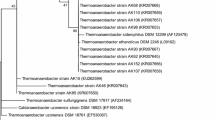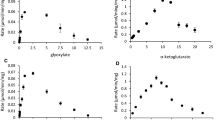Abstract
Eighty-nine microorganisms were isolated that were able to use 2-methyl amino acids and related compounds as the sole source of nitrogen. All of these cultures produced low levels of ammonia in culture supernatant solutions None was capable of fixing nitrogen gas. Whole-cell and cell-free-extract experiments showed that ammonia was not released directly from the 2-methyl amino acids. All of these strains except those isolated with 2-methylserine as a nitrogen source appeared to metabolize 2-methyl amino compounds by a single enzymatic reaction involving simultaneous decarboxylation and transamination. Pyruvate served as an acceptor for the transamination with the concomitant formation of alanine. The strains utilizing 2-methylserine produced a specific 2-methylserine transhydroxymethylase.
Similar content being viewed by others
Literature Cited
Aaslestad EG, Larson AD (1964) Bacterial metabolism of 2-methylalanine. J Bacteriol 88:1296–1303
Bailey GB, Dempsey WB (1967) Purification and properties of an α-dialkyl amino acid transaminase. Biochemistry 5: 1526–1533
Barker HA, Smith RD, Wilson RM, Weissbach H (1959) The purification and properties of β-methylaspartase. J Biol Chem 234:320–328
Burroughs LF (1957) 1-Aminocyclopropane-1-carboxylic acid: a new amino acid from Perry pears and cider apples. Nature 179:360–361
Christensen HN, Jones JC (1962) Amino acid transport models: renal resorption and resistance to metabolic attack. J Biol Chem 237: 1203–1206
Enzyme nomenclature (1984) Recommendations of the nomenclature committee of the International Union of Biochemistry on the nomenclature and classification of enzyme-catalysed reactions. New York: Academic Press, pp 428–429
Flynn EH, Hinman JW, Caron EL, Woolf DO (1953) The chemistry of amicetin, a new antibiotic. J Amer Chem Soc pp 5867–5871
Haga T, Suzuki M (1973) Imparting sweetness to food. Japan Kokai 73:70–784
Inui Y, Akedo H (1965) Amino acid uptake byEscherichia coli grown in presence of amino acids. Evidence for repressibility of amino acid uptake. Biochim Biophys Acta 94:143–152
Jeng I, Barker HA (1974) Purification and properties ofl-3-aminobutyryl Coenzyme A deaminase from a lysine fermentingClostridium. J Biol Chem 249:6578–6584
Kalyankar GD, Snell EE (1962) Pyridoxal-catalyzed decarboxylation of amino acids. Biochemistry 1:594–600
London DR, Segal S (1967) Differences in the uptake and efflux of two non-utilizable amino acids, α-aminoisobutyric acid and 1-amino-cyclopentanecarboxylic acid, but the “cut” rat diaphragm. Biochim Biophys Acta 135:179–180
Lowry OH, Rosenbrough NJ, Farr AL, Randall, RJ (1951) Protein measurement with the Folin phenol reagent. J Biol Chem 193:265–275
Miles EW (1968) α-Methylserine transhydroxymethylase (Pseudomonas). Methods Enzymol XVIIB:341–346
Novogrodsky A, Meister A (1964) Control of aspartate β-decarboxylase activity by transamination. J Biol Chem 239: 879–888
Pfennig N, Lippert KD (1966) Über das Vitamin B12-Bedürfnis phototropher Schwefelbakterien. Arch Mikrobiol 55:245–256
Plantner JJ, Carlson DM (1972) Assay for olefinic amino acids: products of the β-elimination reaction in glycoproteins. In: Methods Enzymol XXVIII: 46–48
Riggs TR, Christensen HN (1965) Use of labeled nommetabolized amino acids in biochemical research. Advan Tracer Methodol 2:183–188
Stadtman TC (1973). Lysine metabolism by Clostridia. Advan Enzymol 38:413–448
Treleum R, Belitz H-D, Jugel H, Wieser H (1978) Relations between structure and taste in amino acids with cyclic side chains. Z Lebensm Unters Forsch 167:311–320
Author information
Authors and Affiliations
Rights and permissions
About this article
Cite this article
Sperl, G.T. Microbial metabolism of 2-methyl amino acids. Current Microbiology 19, 135–138 (1989). https://doi.org/10.1007/BF01570581
Issue Date:
DOI: https://doi.org/10.1007/BF01570581




